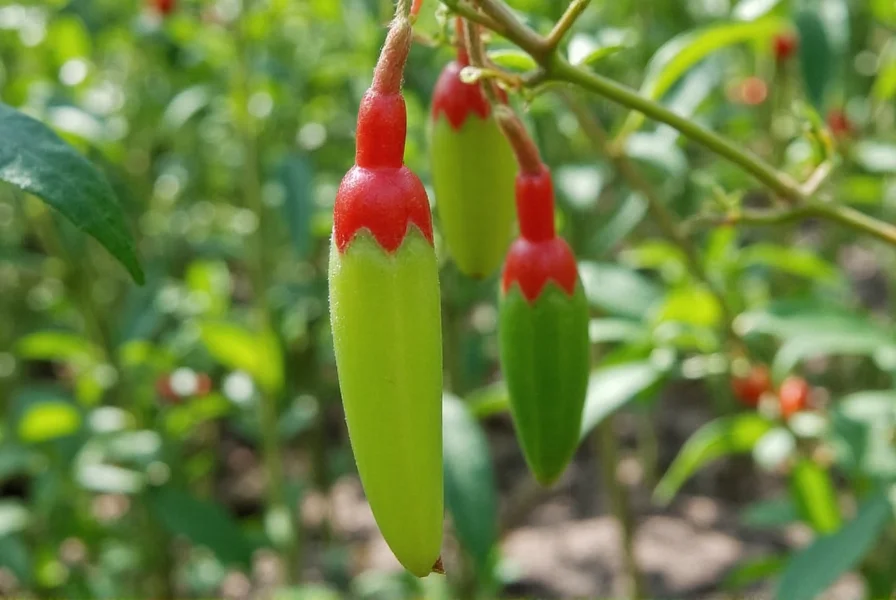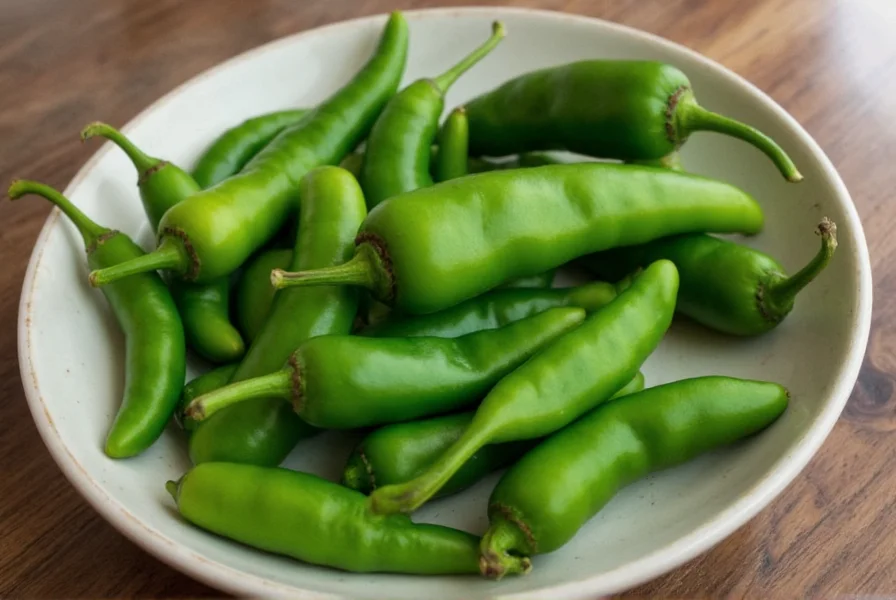Table of Contents
What is a Pequin Pepper?
Pequin pepper (Capsicum annuum) is a small, fiery chili pepper native to Mexico, known for its smoky flavor and heat level of 10,000–30,000 Scoville Heat Units (SHU). This tiny pepper packs a complex, sweet, and smoky taste that enhances a wide range of dishes, making it a versatile ingredient for both savory and sweet recipes. Unlike larger chiles like jalapeños or habaneros, pequin offers balanced heat with distinctive flavor notes that elevate culinary creations without overwhelming them.
Pequin Basics: What You Need to Know
Pequin is a variety of Capsicum annuum, native to Mexico. It's known for its small, round shape and bright red color when ripe. The plant itself is compact, making it ideal for home gardeners who want to grow their own spicy delights.
The heat level of pequin ranges between 10,000 to 30,000 Scoville Heat Units (SHU), which puts it in the medium to hot range. That means it's not as fiery as ghost peppers or Carolina reapers, but it's definitely not a pushover either.

One of the most fascinating things about pequin is its flavor. While many chiles are primarily known for their heat, pequin has a complex, slightly sweet, and smoky undertone that sets it apart. This makes it a versatile ingredient in both savory and sweet dishes.
Whether you're using it fresh, dried, or ground into powder, pequin adds a unique depth of flavor that can transform your cooking. Its versatility is one of the reasons why it's becoming increasingly popular among chefs and home cooks alike.
Pequin in the Kitchen: Practical Tips and Tricks
Now that you know what pequin is, let's talk about how to use it in your kitchen. Here are some practical tips to help you make the most of this tiny powerhouse:
- Start Small: Since pequin can be quite spicy, it's best to start with a small amount and adjust to your taste. Remember, it's easier to add more heat than to remove it.
- Use Fresh or Dried: Pequin can be used both fresh and dried. Fresh chiles are great for salsas, salads, and toppings, while dried pequin can be ground into a powder for seasoning blends or sauces.
- Pair with Complementary Flavors: Pequin's sweet and smoky notes pair well with ingredients like tomatoes, garlic, onions, and even chocolate. Don't be afraid to experiment!
- Make Your Own Pequin Sauce: A simple sauce made with roasted pequin, garlic, lime juice, and olive oil can be a game-changer. Use it on tacos, grilled meats, or even as a dip for chips.
- Try It in Sweet Dishes: Believe it or not, pequin can add a nice kick to desserts like chocolate truffles or spiced cookies. Just keep the quantity low to maintain balance.
Another great tip is to roast or toast pequin before using it. This enhances its flavor and reduces some of the bitterness, making it even more enjoyable. Roasting also helps bring out the smoky notes that make pequin so unique.
If you're feeling adventurous, try incorporating pequin into your morning routine. Add a few crushed seeds to your scrambled eggs or mix them into your oatmeal for a surprising burst of flavor. It's a fun way to introduce yourself to the world of spicy ingredients.
Buying Guide: How to Choose the Best Pequin
When shopping for pequin, whether you're buying fresh, dried, or in powder form, there are a few key factors to consider to ensure you get the best quality:
For Fresh Pequin
Look for firm, plump chiles with vibrant red color. Avoid any that are shriveled, soft, or show signs of mold. Fresh pequin should have a slight sheen and feel heavy for their size.
For Dried Pequin
Dried pequin should be brittle and have a deep red or dark orange hue. Avoid any that are discolored, musty, or have an off smell. Properly dried chiles will last longer and retain their flavor better.
For Pequin Powder
If you're looking for pequin powder, check the label to ensure it's 100% pure pequin and not mixed with other chiles. Look for products that are finely ground and have a rich, reddish-orange color. High-quality powder will have a strong aroma and a noticeable heat without being overly bitter.
Some popular brands of pequin include:
- Pequin Spice Co.: Known for its high-quality, locally sourced pequin, this brand is a favorite among chefs and home cooks.
- MexiSpice: Offers a wide range of chile products, including premium pequin powder perfect for seasoning blends.
- ChileCraze: Specializes in unique chile varieties, including pequin, with detailed descriptions and usage suggestions.
These brands are ideal for those who want to experience the true flavor of pequin without compromising on quality. They're especially suitable for culinary professionals, spice lovers, and anyone looking to elevate their cooking with authentic flavors.
Comparison Tables: Pequin vs. Other Chiles
| Chile Variety | Heat Level (SHU) | Flavor Profile | Best Uses |
|---|---|---|---|
| Pequin | 10,000–30,000 | Smoky, slightly sweet, earthy | Salsas, sauces, seasonings, roasted dishes |
| Jalapeño | 2,500–8,000 | Mild, grassy, slightly sweet | Salads, sandwiches, stuffed peppers |
| Habanero | 100,000–350,000 | Smoky, fruity, citrusy | Hot sauces, salsas, spicy desserts |
| Cayenne | 30,000–50,000 | Pungent, sharp, slightly sweet | Seasoning blends, hot sauces, chili powders |
| Chipotle | 2,500–8,000 | Smoky, rich, slightly sweet | Stews, grilled meats, sauces |

As you can see, pequin falls somewhere in the middle of the heat scale, offering a balanced blend of heat and flavor. Unlike cayenne, which is more pungent and sharp, pequin has a more rounded, smoky character. Compared to habanero, it's milder but still packs a decent kick.
This makes pequin a great all-rounder. Whether you're making a spicy salsa, a smoky sauce, or just adding a little heat to your favorite dish, pequin has got you covered.
Frequently Asked Questions About Pequin
As you explore the world of pequin chiles, you might have some questions. Here are answers to the most common ones:
What is the difference between pequin and tabasco peppers?
While both are hot chiles, pequin and tabasco peppers are quite different. Pequin (Capsicum annuum) is smaller, rounder, and has a more complex flavor profile with smoky and slightly sweet notes. Tabasco peppers (Capsicum frutescens) are longer and tapered, with a fruitier, more vinegar-forward flavor that makes them ideal for tabasco sauce. Pequin typically ranges from 10,000-30,000 SHU, while tabasco peppers range from 30,000-50,000 SHU, making them generally hotter than pequin.
How hot is pequin compared to other common chiles?
Pequin registers between 10,000-30,000 Scoville Heat Units (SHU), placing it in the medium to hot range. It's significantly hotter than jalapeños (2,500-8,000 SHU) and about the same heat level as cayenne peppers, though with a more complex flavor. It's much milder than habaneros (100,000-350,000 SHU) or ghost peppers (855,000-1,041,000 SHU). The heat of pequin builds gradually rather than hitting you all at once, which many find more enjoyable.
Can I grow pequin peppers at home?
Yes! Pequin plants are compact and well-suited for home gardening. They thrive in warm climates but can be grown in containers in cooler regions. Start seeds indoors 8-10 weeks before the last frost, then transplant outdoors when soil temperatures reach at least 70°F (21°C). Pequin plants need full sun, well-draining soil, and regular watering. The small, round peppers typically ripen from green to bright red in about 70-80 days from transplanting.
What are the health benefits of pequin peppers?
Like other chile peppers, pequin contains capsaicin, which has been linked to various health benefits including pain relief, improved metabolism, and reduced inflammation. Pequin is also rich in vitamins A and C, antioxidants that support immune function and skin health. The heat from pequin can also help clear sinuses and may boost endorphin production. As with any spicy food, consume in moderation based on your tolerance.
How should I store pequin peppers to keep them fresh?
Fresh pequin peppers can be stored in a paper bag in the refrigerator's vegetable crisper for up to 2 weeks. For longer storage, dry them by hanging in a warm, dry place or using a food dehydrator. Dried pequin can be stored in an airtight container away from light for up to a year. You can also freeze whole or chopped pequin peppers in a freezer bag for up to 6 months. Frozen peppers are best used directly in cooked dishes without thawing.
Are pequin peppers the same as bird's eye chilies?
No, though they're often confused. Pequin (Capsicum annuum) is native to Mexico and has a rounder shape with a complex smoky-sweet flavor. Bird's eye chilies (Capsicum frutescens) originate from Southeast Asia and are typically longer and more slender with a fruitier, more intense heat. While both register around 10,000-30,000 SHU, their flavor profiles differ significantly. Pequin has more earthy, smoky notes while bird's eye chilies have citrusy, herbal notes.
What dishes work best with pequin peppers?
Pequin's versatile flavor works well in many dishes. It's excellent in salsas, especially roasted tomato salsa. Try it in mole sauces, where its smoky notes complement chocolate beautifully. It adds depth to bean dishes, stews, and grilled meats. For something unique, add a small amount to chocolate desserts or fruit-based sauces. Pequin also makes a wonderful infused oil or vinegar. Its balanced heat and flavor make it suitable for both traditional Mexican cuisine and fusion dishes.
How can I reduce the heat of pequin if I've added too much?
If your dish has become too spicy from pequin, there are several ways to tame the heat. Add dairy products like yogurt, sour cream, or cheese, as the casein helps neutralize capsaicin. Sweet elements like honey, sugar, or fruit can also balance the heat. Acidic ingredients like lime juice or vinegar can help cut through the spiciness. Adding more of the other ingredients in your recipe (like tomatoes or beans) can dilute the heat. Remember that heat from chiles intensifies as they cook, so adding pequin later in the cooking process gives you more control.
Conclusion
Pequin may be small in size, but it's a big player in the world of spices. From its unique flavor profile to its versatility in the kitchen, this tiny chile has a lot to offer. Whether you're a seasoned chef or a curious foodie, pequin is a great addition to your spice rack.
Remember, the key to using pequin effectively is to start small and experiment. With a little practice, you'll be able to harness its heat and flavor to create dishes that are both delicious and exciting. So next time you're shopping for spices, don't forget to pick up a few pequin chiles—they might just become your new favorite.
And if you're ever wondering, 'What's the difference between pequin and other chiles?' now you know. Pequin isn't just another spicy pepper—it's a flavorful, smoky, and slightly sweet addition that can take your cooking to the next level.










 浙公网安备
33010002000092号
浙公网安备
33010002000092号 浙B2-20120091-4
浙B2-20120091-4